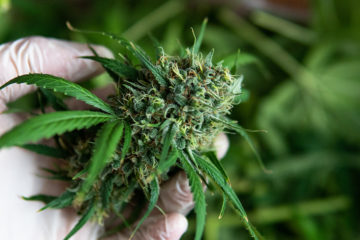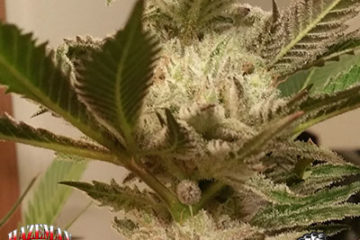by Jyothirmai Gubili, MS, Eugenie Spiguel, MSN, ANP-BC, and Nirupa Raghunathan, MD
An annual flowering herb native to East Asia, Cannabis sativa is cultivated around the world. It is used in traditional medicine as an analgesic, hypnotic, hallucinogenic, sedative, and anti-inflammatory. Preparations derived from its flowers, leaves, and hashish made from its resinous extract are taken orally, by smoking, or by vaporizing. Cannabis teas, tinctures, ointments, and oil-based extracts that can be mixed into food products are also popular.
The most widely used illicit agent around the world, cannabis is a controversial subject in the United States because of its potential for abuse and dependence. Use has been associated with high risks of addiction, serious side effects, and withdrawal syndrome.
What the Research Reveals
Active constituents of cannabis are cannabinoids that include delta-9-tetrahydrocannabinol (THC), the main psychoactive component, and cannabidiol (CBD), a nonpsychoactive cannabinoid. When taken together, CBD mitigates the adverse psychotropic and cardiovascular effects associated with THC.
Randomized trials showed effectiveness of an oral CBD solution for decreasing the frequency of seizures in patients with two rare forms of epilepsy, Lennox-Gastaut syndrome or Dravet syndrome; the formulation is now a U.S. Food and Drug Administration-approved therapy. In addition, the American Academy of Neurology issued a summary of systematic reviews for clinicians highlighting benefits of cannabis for reducing spasticity and pain associated with multiple sclerosis.
However, a comprehensive review of 79 trials (6,462 subjects) did not find strong evidence to support cannabis use to address sleep disorders, increase appetite, or treat Tourette. The evidence for recommending cannabinoids to treat symptoms of Parkinson and Huntington diseases, dyskinesia, irritable bowel syndrome, and addiction was also insufficient or unavailable. Data on effectiveness in chronic noncancer pain are mixed.
In cancer settings, systematic reviews reported benefit of cannabis against chemotherapy-induced nausea and vomiting. The 2017 American Society of Clinical Oncology guidelines for antiemetics in oncology recommended dronabinol and nabilone (FDA-approved synthetic cannabinoids) for nausea and vomiting that is resistant to standard treatment. Findings also suggested utility of THC and nabixomols spray (a cannabis extract) for reducing pain and of dranobinol for managing paraneoplastic night sweats. But cannabis did not improve cancer-related anorexia-cachexia syndrome.
In the context of managing cancer itself, dose-dependent disease control was reported with a cannabinoid resin extract in a patient with acute lymphoblastic leukemia. And cannabis use during immunotherapy with nivolumab was associated with reduced tumor response rate in advanced melanoma, non-small cell lung cancer, and renal clear cell carcinoma.
As more research emerges indicating potential benefits of cannabis, the National Academy of Medicine said that further studies are needed to fully understand its effects on human health.
Adverse Effects
Oncology nurses should be aware of cannabis’s toxicities and watch for the reported side effects in patients who are using the drug.
Short-term effects of medical cannabinoids include dizziness, dry mouth, nausea, fatigue, somnolence, euphoria, vomiting, disorientation, drowsiness, confusion, loss of balance, and hallucination.
Regular use of cannabis products is associated with chronic bronchitis.
Inhalation of cannabis products has been linked to myocardial infarction, sudden cardiac death, cardiomyopathy, stroke, transient ischemic attack, and cannabis arteritis.
Cannabis use can elevate the risk of rare, but life-threatening cardiac dysrhythmia, acute coronary syndrome, and chronic cardiovascular disease.
A risk of addiction exists.
After stopping cannabis use, patients may experience symptoms of withdrawal syndrome, including irritability, sleeping difficulties, dysphoria, craving, and anxiety.
Two deaths following chronic cannabis use were attributed to cannabis hyperemesis syndrome (CHS), involving cyclic attacks of nausea and vomiting. Another case report showed that benzodiazepines relieved CHS symptoms.
Compared to natural cannabis, synthetic cannabinoid drugs cause more serious adverse effects, which include respiratory difficulties, hypertension, tachycardia, chest pain, muscle twitches, acute renal failure, anxiety, agitation, psychosis, suicidal ideation, and cognitive impairment.
Implications for Nursing
Despite the controversy surrounding cannabis, it is approved in 33 states and the District of Columbia (DC) for medical use, with 11 states and DC also allowing recreational use. Cancer symptoms, noncancer pain, glaucoma, AIDS, epilepsy, and multiple sclerosis are some indications that qualify for medical cannabis use.
Because a cancer diagnosis is an indication for medical marijuana, oncology nurses must be well informed about the indications and potential risks as well as the state laws regarding its use. Despite the negative connotations often associated with medical marijuana use, some patients may benefit. Oncology nurses can help guide patients and assist in referrals to an appropriate provider when indicated.


